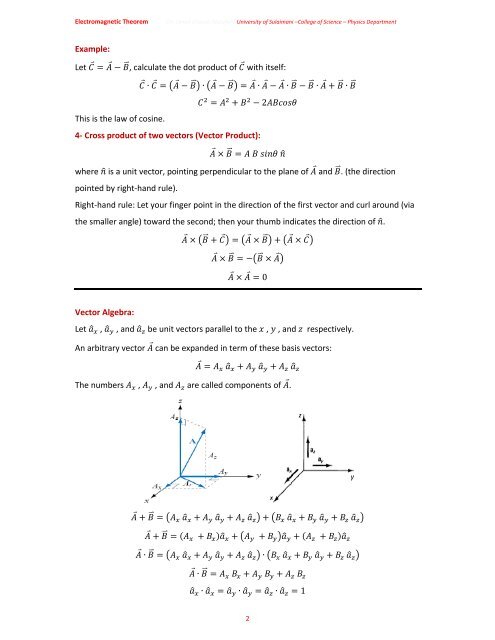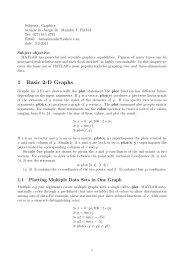Chapter One: Vector Analysis The use of vectors and vector analysis ...
Chapter One: Vector Analysis The use of vectors and vector analysis ...
Chapter One: Vector Analysis The use of vectors and vector analysis ...
You also want an ePaper? Increase the reach of your titles
YUMPU automatically turns print PDFs into web optimized ePapers that Google loves.
Electromagnetic <strong>The</strong>orem<br />
(Dr. Omed Ghareb Abdullah) University <strong>of</strong> Sulaimani –College <strong>of</strong> Science – Physics Department<br />
Example:<br />
Let , calculate the dot product <strong>of</strong> with itself:<br />
∙ ∙ ∙ ∙ ∙ ∙<br />
2<br />
This is the law <strong>of</strong> cosine.<br />
4‐ Cross product <strong>of</strong> two <strong><strong>vector</strong>s</strong> (<strong>Vector</strong> Product):<br />
<br />
where is a unit <strong>vector</strong>, pointing perpendicular to the plane <strong>of</strong> <strong>and</strong> . (the direction<br />
pointed by right‐h<strong>and</strong> rule).<br />
Right‐h<strong>and</strong> rule: Let your finger point in the direction <strong>of</strong> the first <strong>vector</strong> <strong>and</strong> curl around (via<br />
the smaller angle) toward the second; then your thumb indicates the direction <strong>of</strong> .<br />
<br />
<br />
0<br />
<strong>Vector</strong> Algebra:<br />
Let , , <strong>and</strong> be unit <strong><strong>vector</strong>s</strong> parallel to the , , <strong>and</strong> respectively.<br />
An arbitrary <strong>vector</strong> can be exp<strong>and</strong>ed in term <strong>of</strong> these basis <strong><strong>vector</strong>s</strong>:<br />
<br />
<strong>The</strong> numbers , , <strong>and</strong> are called components <strong>of</strong> .<br />
<br />
<br />
∙ ∙ <br />
∙ <br />
∙ ∙ ∙ 1<br />
2
















